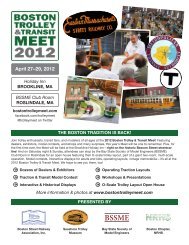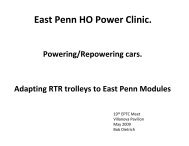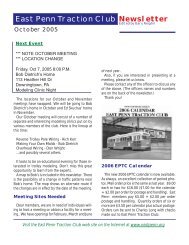Create successful ePaper yourself
Turn your PDF publications into a flip-book with our unique Google optimized e-Paper software.
Which Method is Better?The answer to this question depends on whom you ask, but let’s look at some particulars so you candecide for yourself. Both arrangements will be shown in subsequent chapters.The advantage of pole reverse wiring is that changing ends (raising one pole and lowering the other)changes which motor lead is positive and which is negative, automatically reversing the car. Insteadof throwing a direction switch on a control panel, the operator is using the trolley poles, thrown inunison, as a double-pole, double-throw switch. The end result is basically the same.If you operate any point-to-point routes with no loops, or a point-to-loop route, direct wiring canmake it difficult to operate and to remember which way different cars are facing. The NMRA standardrequires a car to move “forward” with a positive overhead, but if your car is double ended,which end is forward? This is not just an academic issue. On a large layout or module setup, manycars can be operated simultaneously with one control. Would you like to put your car on the track orstart it up without worrying about which end of your car is “forward”? Would you like to be able torun it with either end forward (for example, baggage or coach end)? Would you like to reverse a carinto a trailing-switch siding or crossover, while all other cars continue forward uninterrupted? Polereverse offers these advantages.Pole reverse wiring has its disadvantages, too. For one thing, the modeller must electrically insulatethe poles, which is sometimes difficult to do on a metal roof (Walthers offers insulated bushings).The pole hooks have to be wired, which may also be difficult on a particular commercial model. Polereverse is hard to engineer on a car with only one pole or with pantographs. Having a mixed fleet ofdirect-wired and pole reverse cars can make operations confusing! Some modelers also argue thatpole reverse wiring involves more wires inside the confines of the carbody than direct wiring, andrequires more connections between the carbody and the roof or floor, whichever is removable formaintenance. These points would appear to be true, based on the two figures shown above. Rememberingthat the motor is usually in a power truck, it looks like three connections are needed (twomotor leads and the ground wire), while the direct-wired car seems to need only one connection. Aswe shall see in a future installment, this is not really the case if you also want operating lights. Withthe lights factored in, the wiring added for pole reversal is minimal. Let’s clear up another misconception,while we’re at it. The pole reverse wiring scheme does not prohibit an operator from backinga car “against the pole.” Just throw that old direction switch on the control panel, the same asalways.Next we will look at more complicated circuits with interior lights, headlights, and taillights. A morepractical wiring diagram method will be introduced. Beyond that, we will drift into relatively new,not classic, wiring methods. We will review the so-called constant voltage lighting, light-emittingdiodes (LED’s), can-style motors, and other subjects.Part 2: The ClassicsOperating Lights (and Diodes)Many modellers add working lights to model trolleys. In the classic method (Figure 3 shows directwiring), 12 volt bulbs are wired in parallel to the motor. They see the same varying voltage that the






